 |
|
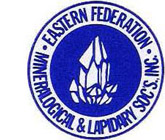
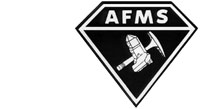
|
|
HOME PAGE
Earth & Mineral Sciences Museum and Art Gallery LINKS |
Fluorite: Specialization in mineral collecting The hobbyist mineral collector faces a dilemma: there are over 5500 minerals recognized by the International Mineralogical Association. Very few individuals will ever be able to collect them all. One solution to assembling a satisfying collection is specialization - limiting one’s scope of collecting. Examples of such limits include:
Pure fluorite is transparent and colorless. The many colors it may exhibit are allochromatic, caused by impurities or crystal irregularities, not the pure mineral itself. Geologyin.com has an article with great photos about Why Fluorite Comes In Different Colors. Fluorite crystallizes in the cubic system, with the most common form being a cube, although octahedra and other forms do occur. It has perfect cleavage in four directions, making it relatively easy to cleave octahedra from a larger mass. 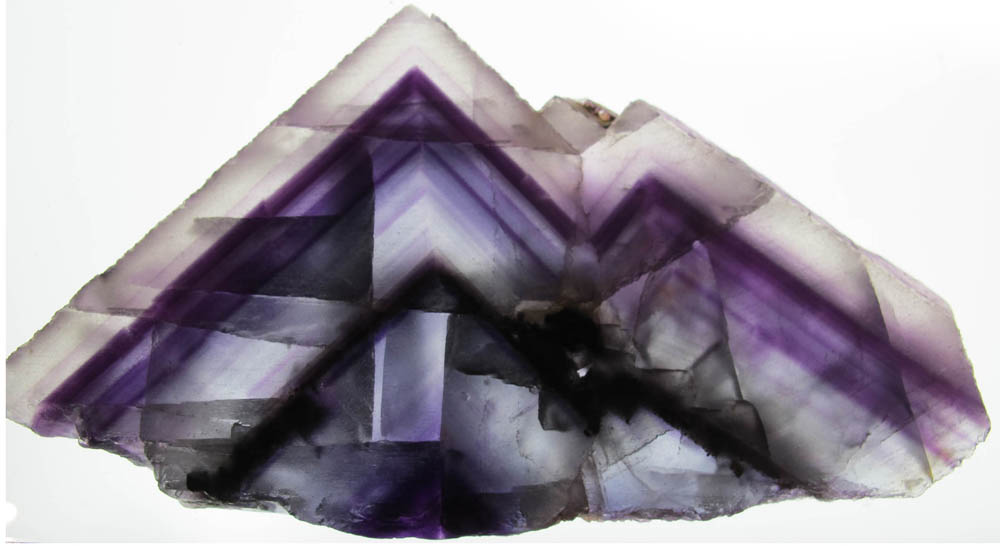 Zoning
ZoningColor zoning is well known in fluorite. The slice through a crystal group in the center of the display is zoned purple to clear. Other specimens in the display show zoning of yellow to purple and blue. 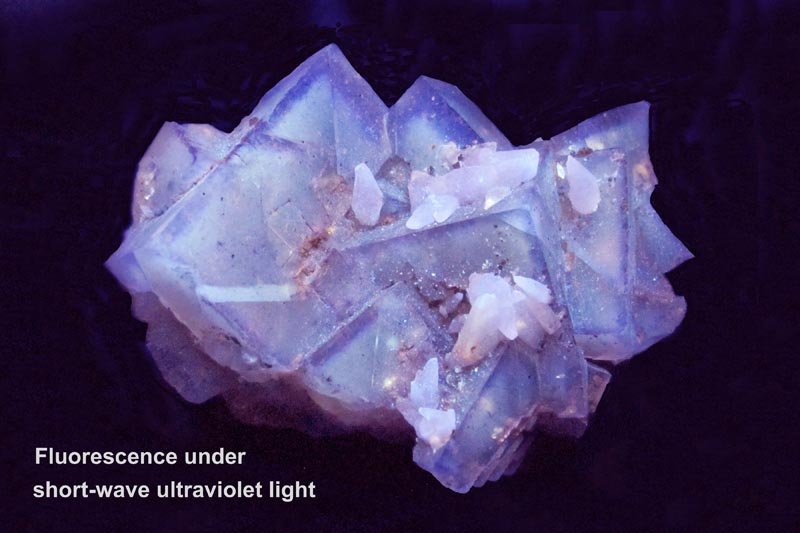 Fluorescence
FluorescenceThe phenomenon of fluorescence, emitting light due to excitation by light of higher energy (shorter wavelength), was named for the mineral fluorite. Even before artificial sources of ultraviolet light were available, some fluorite was observed to have “daylight fluorescence” in which the fluorescence excited by the ultraviolet portion of sunlight was bright enough to be visible even in daylight. 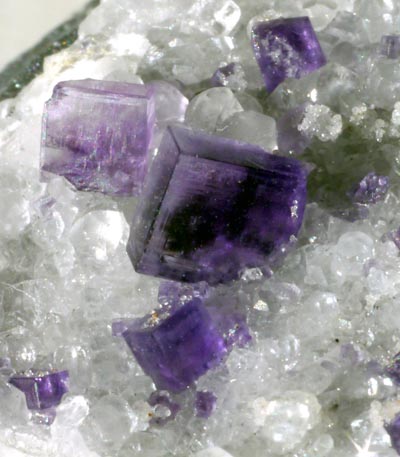 Fluorite in Pennsylvania
Fluorite in PennsylvaniaFluorite occurs in several places in Pennsylvania, particularly in carbonate rocks from the center of the state to the southeast. The most common color is “grape juice purple;” pale purples and blues also occur. Crystals tend to be either small or embedded in calcite from which they are difficult to remove. The image at right shows small fluorite cubic crystals on calcite from the Burkholder Quarry, Lancaster County, Pennsylvania. The large large crystal measures 4 mm. Photo by D. Glick. Fluorite occurs around the world. Some prime localities for collectible specimens include the Illinois-Kentucky Fluorspar District, China, Derbyshire in England, southern Germany, the south of France, and Russia. See Mindat's fluorite gallery for a wide variety of photos. The name fluorite came from the Latin word for flow. Fluorite has historically been used as a flux in iron smelting, allowing the slag to flow more easily. It is also used along with the fluoride mineral cryolite (Na3AlF6) in refining aluminum. Many fluorine compounds are used as industrial chemicals. Fluorite is reacted with sulfuric acid to make hydrofluoric acid as the first step in synthesizing these chemicals. Fluorite has also been used for special low-dispersion optical lenses in cameras and telescopes, but these fluorite crystals are synthetically grown. It is used for enamels and other coatings as well. Although its colors would be useful in jewelry, fluorite is much softer (4 on the Mohs scale of mineral hardness) than most gemstones, and would wear quickly. It is used for carvings and decorative objects which would not experience much handling. https://www.minerals.net/mineral/fluorite.aspx https://www.sciencedirect.com/topics/earth-and-planetary-sciences/fluorite |
 NMS has in stock T-shirts in Galapagos blue, Texas orange (both shown here) and royal blue. 
A station at our Minerals Junior Education Day  2020: CELESTINE: Pennsylvania State Mineral?
2020: CELESTINE: Pennsylvania State Mineral?

Collecting crystals in a quarry 
We have 2013 (and other) posters for sale! |
|
| ||